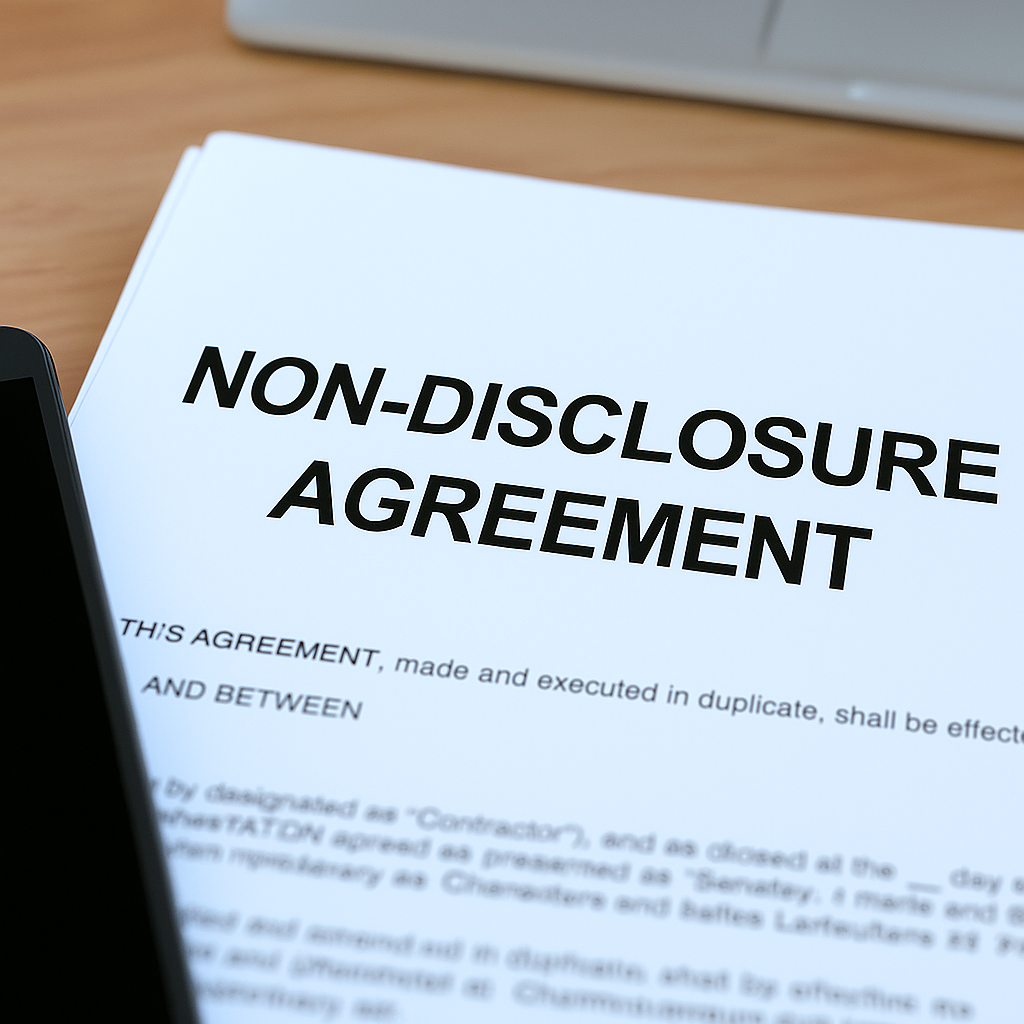NDA Agreement in Machining: A Complete Guide
 Nov 19,2025
Nov 19,2025

In machining, non-disclosure agreements (NDA) are common for clients or manufacturers having negotiations with the service providers. They help both parties to share sensitive information without any risks. It is called a mutual non-disclosure agreement for some cases. The details of this agreement, like its scope or types of NDA, are all discussed in this article.

What Is an NDA Agreement?
NDA is a legal contract to create a confidential relationship between parties. It prevents the recipient from sharing sensitive information disclosed by the discloser.
Why Do Companies Use NDAs?
Companies use NDAs to protect trade secrets and business strategies. It also protects the proprietary information from unauthorized disclosure, that is important for having a competitive advantage.
Common Using Scenarios
There are few scenarios when NDA is used like:
- To hire new employees who will have access to sensitive data.
- To explore potential business partnerships.
- To seek investment from other investors.
- To hire independent contractors or freelancers.
Confidential Vs. Non-Confidential Information
NDA defines what information to be considered confidential or what can be used and shared. Non-confidential information is publicly available information. The non-confidential already know before signing the agreement.
Discloser Vs. Recipient
Discloser is the party sharing confidential information and recipient is the party agreeing to keep it secret.
How NDAs Work in Practice
In manufacturing and machining. NDA is used to protect the proprietary designs like blueprints of parts, production process, machining parameters and new product development details from early-stage partners and suppliers.
Types of NDAs in Manufacturing
There are a few types of NDAs that are used in manufacturing. The details of each type are as follows:
Unilateral NDAs
It is an agreement where only one party discloses confidential information. And the disclosing party is only bound by confidentiality obligations. It is used when sharing proprietary information, like product designs or technical specifications
What Is NNN Agreement?
NNN agreement (Non-disclosure, Non-use and Non circumvention) is more comprehensive than NDA. It is important for business in China due to a higher risk of intellectual property theft and circumvention.
NDA vs. NNN
NNN agreement in machining prevents disclosure and misuse of information. It tops the recipient from bypassing the other party. NDA agreements prevent the recipient from disclosing confidential information to a third party.
Mutual NDAs
It is an agreement when both are sharing confidential information, and both are bound by confidentiality obligations. It is used during ongoing partnerships, or mergers when both parties need to share their sensitive information
Multilateral NDAs
It is used when three or more parties are involved where at least one party will disclose information to the others. It is used for complex collaboration with multiple companies who all need sensitive information like supply chain developers, manufacturers, and a distributor.
What to Include in an NDA
There are a few elements that must be added to the non-disclosure agreement. What are the 5 key elements of a non-disclosure agreement? The details of these elements are as:
1.Define The Parties Involved
It identifies all the members and companies who are a part of agreement. It includes the "Disclosing Party" and the "Receiving Party". For example, a machining company is entering an agreement with a potential partner to discuss a new custom part.
2.Definition of Confidential Information
It provides details of what information is considered confidential and protected under the agreement. For example, it specifies the confidential information as technical data, proprietary manufacturing processes, CAD files, customer lists, and detailed cost breakdowns for specialized tools.
3.Recipient's Responsibilities
It defines the obligations of the party to receive the information. It includes not using the information for their own benefit and protecting it. For example, the receiving party should not disclose CAD files for their own production.
4.Exclusions from Confidentiality
It includes all the types of information in listicle form that are not covered by the NDA. For example, information to be disclosed by court order is typically excluded.
5.Term of The Agreement
It states the specific duration for which the confidentiality obligations will remain in effect. For example, the confidentiality obligations will last for three years from the date of the agreement.
What Does an NDA Not Protect?
There are a few things that are not included in the NDA and are not protected in the legal agreement.
Public & Prior Knowledge
That information is not included in NDA in manufacturing that is already public knowledge. Or information that was in the possession of the receiving party before signing the NDA is not protected.
Legally Compelled Disclosures
NDA cannot prevent a party from disclosing information if a court orders them to do so.
Illegal Acts & Public Policy
NDA in manufacturing is not enforceable if it requires a party to conceal illegal activities. Or if it violates public policy like by preventing reporting of wrongdoing.
How to Get a Non-Disclosure Agreement (NDA) with TUOFA?
TUOFA is a highly reputable partner. To get an NDA with TUOFA, contact us directly. The NDA for a machining project with TUOFA will clearly define the information to be protected, specifying the obligations of both parties, the duration of the agreement, and standard legal clauses.
When to Use NDAs in Machining?
NDA in machining is normally used when outsourcing custom machining, sharing proprietary designs, working with new suppliers and external engineers and protecting trade secrets
DFM Process for Custom Projects
DFM process for custom projects involves preparing files with NDA to protect intellectual property when outsourcing. The DFM review and file preparation ensures manufacturable designs and NDA protects sensitive information.
NDA Agreement in Machining Sample
NDA agreement in machining must clearly define the confidential information and who can access it and the consequences of unauthorized disclosure.
Subcontracted Plating
When outsourcing the services, NDA agreement in outsourcing include a Request for Quotation with DFM files, then purchase order with NDA and schedule the delivery plan with milestones.
Files Preparing
Prepare the NDA files with final designs like STEP models with 2D drawings with the exact revision status.
Preparing Machining Files
The machining files must include all the quality requirements like standards ISO 9001, AS9100, inspection levels, and other critical features. Confirm the data format like TEP or Parasolid models
NDA Agreement in Machining Template Word
A very basic NDA agreement template word is shown below. This is just to show an example of NDA template or as a NDA agreement in machining sample:


What Are The 10 Red Flag Symptoms?
NDA in machining is used when a company is developing a new product and does not want to share information through suppliers, advisers, or potential partners. There are some of the common red flag symptoms of NDA which are briefly explained below:
- Undefined Confidential Information: The scope of confidential information is not clearly defined in the NDA.
- One-Way NDA: The NDA restricts only one party and not both.
- Overbroad Residuals Clause: This allows the receiving party to use information in not deliberated ways.
- No Return or Destruction Duty: NDA does not require the return of confidential information upon termination.
- No Injunctive Relief: NDA doesn't define that the disclosing party can get an injunction if it is breached.
- Unlimited Internal Sharing: NDA let the receiving party to share the information with any employee without any consent.
- No Subcontractor Flow-Down: NDA doesn't require subcontractors to be bound by the same confidentiality obligations.
- Marketing Use of Your Parts: NDA let the receiving party to use your parts for marketing purposes without consent.
- Request for Native CAD/CAM before NDA: The other party is asking for native CAD/CAM files before an NDA is in place.
- Excluding Drawings and Process Data: Drawings, specifications, and process data are not included in the definition of confidential information.
How to Negotiate and Manage NDAs
NDA must be negotiated and managed by clearly defining the scope, duration, and purpose of the agreement upfront. Use simple and easy to understand language. During negotiation, explain confidential information with fairness and balance and include clauses for the return or destruction of information. Do not release sensitive information before the NDA is signed. NDA is managed by securing physical and digital information with the consent of all the parties and having a process to handle breaches and updates.
Conclusion
In machining, NDA is a legally binding contract to prevent a partner or manufacturer from disclosing confidential and proprietary information. This information can be product designs, trade secrets, and production processes. It is essential to protect the intellectual property and not to share the designs with competitors. NDA is important before sharing sensitive information with potential manufacturing partners.
FAQs
How long do NDAs typically last?
NDA can last for several months or from one to five years depending on the nature of the information being protected.
What’s the difference between a CDA and an NDA?
NDA and CDA (confidently disclosure agreement) are very similar, and the terms are often used interchangeably. A CDA is focused on the process of disclosing specific technical information. And the NDA is focused more broadly on general business information and a wider range of topics.
 Tel/WeChat:
Tel/WeChat:  Email:
Email: 
 Home
Home
 Thread Pitch: Charts, Design, Measurement & Machining
Thread Pitch: Charts, Design, Measurement & Machining 







